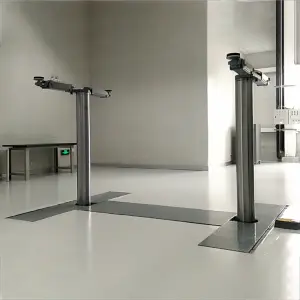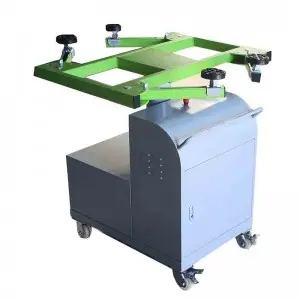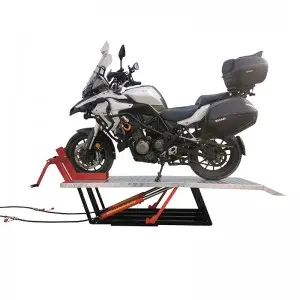In the world of automotive service and repair, the tools and equipment utilized can significantly influence the efficiency, safety, and productivity of a workshop. Among the various types of lifting equipment available, the inground lift stands out as a pivotal asset for mechanics and vehicle maintenance professionals. This article delves into the advantages, functionality, installation considerations, and maintenance of inground lifts, explaining why they are becoming the preferred choice in modern automotive services.

Understanding Inground Lifts: The Ultimate Solution for Efficient Vehicle Maintenance in Automotive Workshops
What is an Inground Lift?
An inground lift is a type of vehicle lift that is installed below the ground level, allowing vehicles to be raised for inspection, repair, and maintenance without the obstruction of a platform or ramp. These lifts are highly beneficial in professional automotive shops due to their space-saving design, enabling technicians to move freely around the vehicle while it is elevated. Typically constructed from durable materials such as steel, inground lifts feature hydraulic or pneumatic mechanisms that facilitate the lifting and lowering of various types of vehicles, from passenger cars to heavy-duty trucks.
Advantages of Inground Lifts

Understanding Inground Lifts: The Ultimate Solution for Efficient Vehicle Maintenance in Automotive Workshops
1. **Space Efficiency**: One of the most significant advantages of inground lifts is their space-saving design. Since the lift is installed below ground, it does not occupy any surface area, allowing the workshop to maximize usable space. This design is particularly beneficial in smaller garages, where space is at a premium.
2. **Unobstructed Access**: Inground lifts allow for easier access to the underside of the vehicle, providing ample room for technicians to work. Without a lift obstructing movement, workers can crouch under the vehicle to perform repairs, inspections, or maintenance tasks more comfortably and safely.
3. **Enhanced Safety**: Safety is paramount in any automotive workshop. Inground lifts minimize the risk of accidents caused by lifting platforms or ramps, as they do not create tripping hazards. Additionally, the mechanisms used in these lifts are engineered to provide a stable and secure lifting experience.
4. **Versatility**: Inground lifts come in various designs and lifting capacities, accommodating different types of vehicles. Whether operating on compact cars or large trucks, inground lifts can be used effectively for a wide range of automotive service tasks.
5. **Durability**: Constructed to withstand heavy loads and frequent use, inground lifts are built for longevity. Their below-ground installation protects them from environmental factors, leading to reduced wear and tear over time.
Installation Considerations
While inground lifts present numerous advantages, proper installation is critical for optimal functionality and safety. The installation process requires considerable planning and expertise, making it advisable to hire a professional service for the job. Key considerations during installation include:
– **Foundation**: The ground must be excavated to create a deep enough foundation for the lift. The depth and dimensions of the pit will depend on the lift’s specifications and the vehicles it will service.
– **Drainage**: Proper drainage systems must be in place to prevent water accumulation in the pit, which could lead to corrosion or mechanical issues.
– **Accessibility and Clearances**: Ensure that there is enough space around the lift for technicians to maneuver safely while working on the vehicle.
Maintenance Recommendations
To ensure the ongoing efficiency and safety of inground lifts, routine maintenance is essential. Here are some recommended maintenance practices:

Understanding Inground Lifts: The Ultimate Solution for Efficient Vehicle Maintenance in Automotive Workshops
1. **Regular Inspections**: Conduct regular inspections to check for any signs of wear, corrosion, or mechanical failure. Early detection of issues can prevent costly repairs and accidents.
2. **Lubrication**: Proper lubrication of moving parts is vital for smooth operation. Follow the manufacturer’s guidelines regarding lubrication schedules and products.
3. **Cleaning**: Keep the lift area clean and free of debris. Dirt and grime can interfere with the lifting mechanism and lead to operational problems.
4. **Professional Servicing**: Schedule regular professional servicing to ensure that all components are functioning as intended and to address any potential concerns.
Conclusion
In conclusion, inground lifts represent a significant innovation in the automotive repair industry, offering numerous advantages in terms of space efficiency, safety, and versatility. Their professional installation and regular maintenance can extend their lifespan and enhance vehicle service capabilities. For automotive workshops looking to improve their operational efficiency while creating a safer working environment, investing in an inground lift is undoubtedly a wise decision. As technology and design continue to evolve, inground lifts will likely remain a cornerstone of modern vehicle maintenance practices.quick car jack lift
